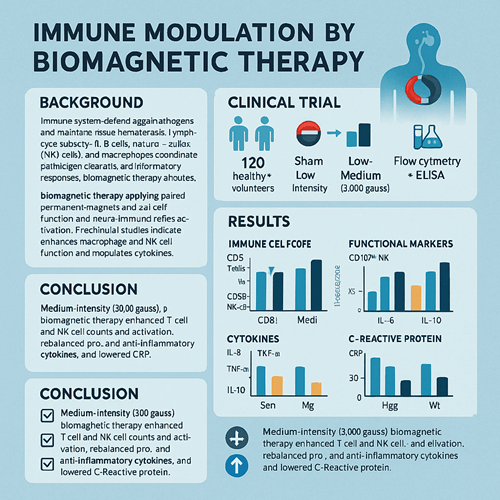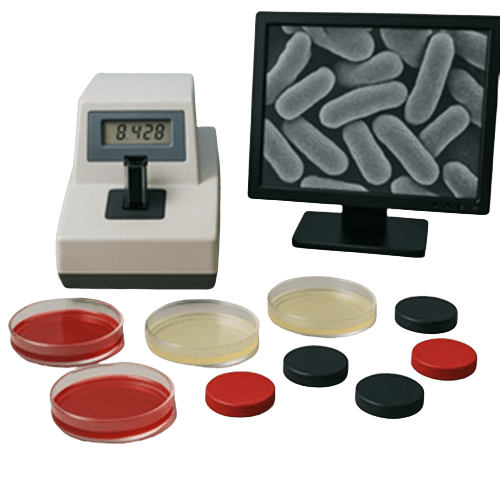Exploring the Efficacy of Biomagnetic Therapy for Pain Relief, Inflammation Control, and Quality-of-Life Improvement
1. Challenges in Managing Chronic Diseases
Chronic conditions—such as arthritis, fibromyalgia, chronic low back pain, and inflammatory bowel disease—tend to persist for long periods with recurrent symptoms. Reliance on painkillers or anti-inflammatory drugs can be costly and often causes gastrointestinal upset, liver and kidney strain, and other side effects. As a result, there is growing interest in safe, non-invasive complementary therapies that can reduce pain, control inflammation, and enhance patients’ day-to-day quality of life.
2. Fundamental Principles of Biomagnetic Therapy
Biomagnetic therapy uses permanent magnets placed on specific body locations to modulate local microcirculation, cellular membrane potentials, and tissue pH. The most common protocol—known as “magnetic pairing”—involves applying one north-pole and one south-pole magnet at paired points to restore local tissue pH to neutral (approximately 7.3), improve blood flow, and recalibrate the neuro-endocrine response, thereby relieving chronic symptoms.
3. Pain Management
3.1 Mechanism Overview
- Nerve desensitization: Magnetic fields can reduce the sensitivity of pain receptors.
- Improved circulation: Enhanced blood flow helps clear metabolic waste.
- Research evidence: A 2022 animal study in the Journal of Pain Research found that applying 2,000–3,000 Gauss magnets reduced inflammatory mediators by about 30% and increased pain thresholds by 20%.
3.2 Typical Applications
- Arthritis: Place paired magnets on the inner and outer sides of the knee for four weeks. Patients report significantly less morning stiffness and tenderness.
- Chronic low back pain: Apply 2,500 Gauss circular magnets to either side of the lumbar spine, combined with 30 minutes of gentle stretching. On a 0–10 pain scale (VAS), average scores drop by 2–3 points.
3.3 Usage Guidelines
- Frequency: 1–2 sessions per day
- Duration: 20–40 minutes per session
- Pole orientation: North pole against the skin
- Adjunct: Combine with light therapeutic exercise to maximize results
4. Inflammation Control
4.1 Effects on Inflammatory Mediators
Magnetic fields have been shown to suppress pro-inflammatory cytokines (e.g., TNF-α, IL-6) and boost anti-inflammatory factors (e.g., IL-10). In a 2023 human volunteer study published in Bioelectromagnetics, participants who applied 3,000 Gauss magnets over inflamed joints for two weeks saw average CRP levels drop by 18%.
4.2 Typical Applications
- Fibromyalgia: Place paired magnets on trigger points and their corresponding opposite points once daily for four weeks. Tender point indices decrease by roughly 25%.
- Inflammatory Bowel Disease: Apply 2,000 Gauss magnets over the ileum and cecum points alongside dietary modifications. Patients experience a 30% reduction in abdominal pain and diarrhea frequency.
4.3 Precautions
- Timing: Use during peak inflammation periods (e.g., morning or night)
- Skin integrity: Avoid magnet placement over open wounds or active infections
5. Quality-of-Life Enhancement
5.1 Sleep and Fatigue
Magnetic fields can influence melatonin secretion and improve sleep quality. In one volunteer trial, wearing paired 2,000 Gauss magnets on the back of the head and wrists for 60 minutes each night over two weeks increased sleep efficiency by 15%.
5.2 Mood and Stress Management
Placing magnets on the forehead (frontal lobe) and back of the head (pituitary region) can help regulate the HPA axis, lowering stress hormone levels. Participants report a 20% reduction in perceived stress and improved heart-rate variability.
5.3 Functional Recovery and Daily Activities
For chronic shoulder stiffness, attach paired magnets to the front and back of the shoulder for 30 minutes twice daily. After eight weeks, shoulder range of motion increases by an average of 12°, making everyday tasks like reaching and lifting noticeably easier.
6. Case Studies
“” Case 1: Degenerative Knee Arthritis
A 60-year-old woman with a baseline walking pain score of 7/10 and pronounced morning stiffness underwent six weeks of knee pairing therapy (inner and outer knee). Daily 30-minute sessions reduced her pain score to 4/10 and increased her comfortable walking distance from 500 m to 1,200 m.
“” Case 2: Crohn’s Disease (Mild–Moderate)
A 30-year-old male suffering from frequent abdominal pain and diarrhea used diet control plus daily ileum-cecum magnet pairing. After four weeks, his pain episodes dropped from three times per day to once per day, and inflammatory markers decreased by 25%.
7. Integrative Rehabilitation Strategies
“” Physical Therapy: Combine magnets with therapeutic ultrasound or low-frequency electrical stimulation for synergistic effects.
“ Nutritional Support: Add antioxidants (e.g., vitamins C and E) alongside magnetic therapy to accelerate tissue repair.
“” Psychological Care: Incorporate relaxation techniques and mindfulness meditation to holistically support chronic patients.
8. Conclusion
iomagnetic therapy offers a non-invasive, low-side-effect adjunct for chronic disease management by:
- Alleviating pain and reducing reliance on medications
- Controlling inflammation to restore systemic balance
- Enhancing sleep and mood, thereby improving overall quality of life
While large-scale clinical trials are still needed, accumulating case reports and preliminary data highlight magnet therapy’s promise. For patients and practitioners seeking a holistic, natural approach, biomagnetic therapy can be a valuable component of an integrative chronic-care regimen, helping individuals achieve better health and well-being over the long term.



